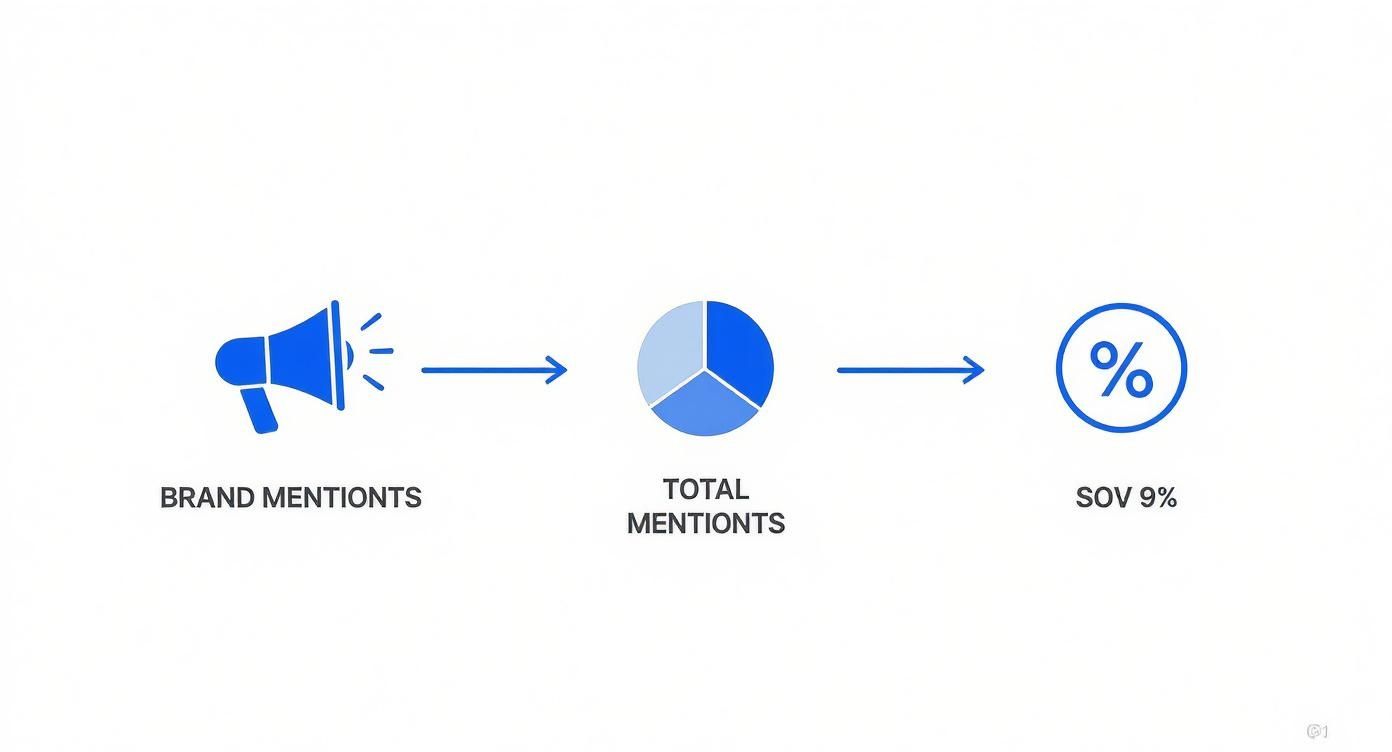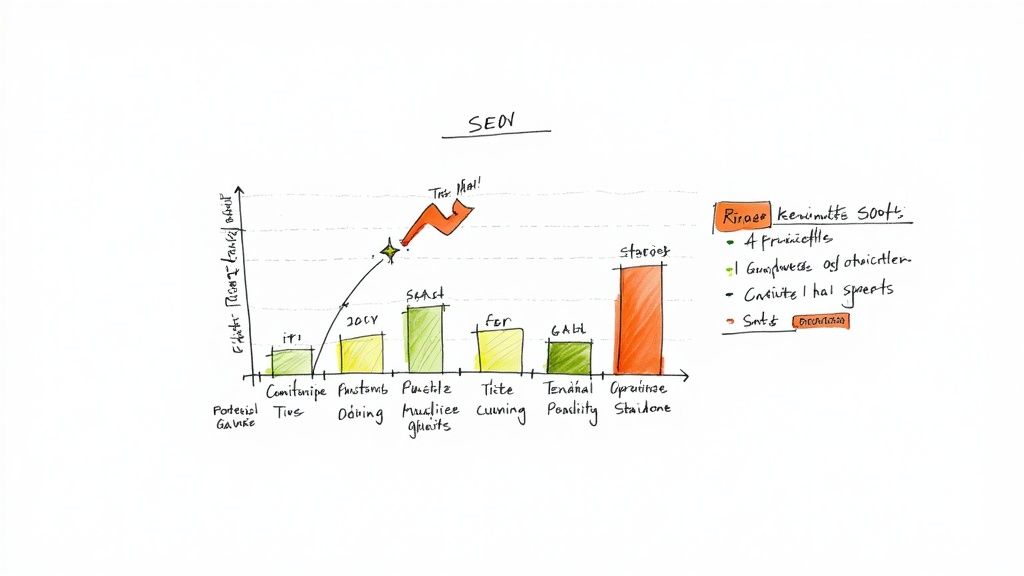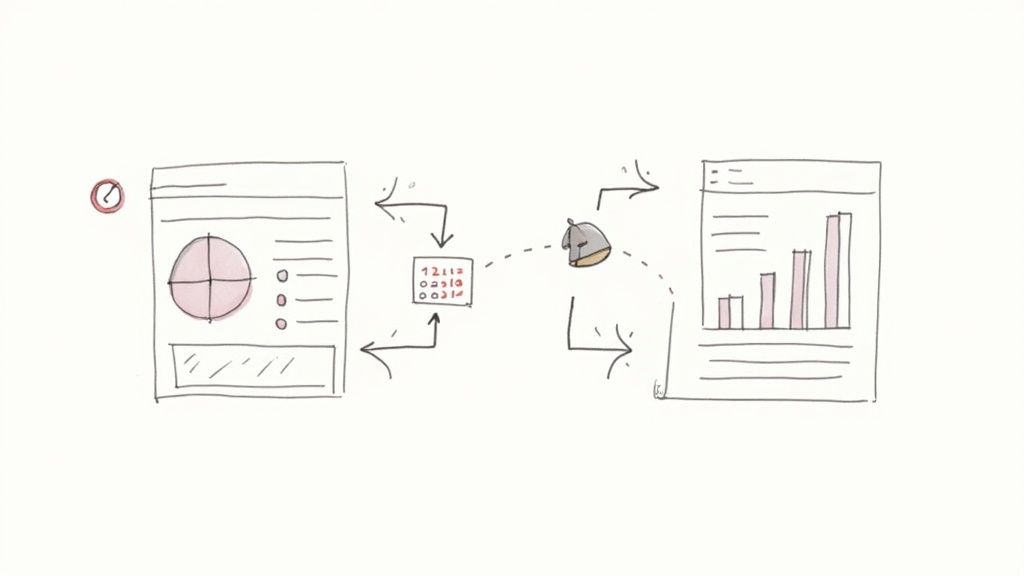You think you know your share of voice (SOV), but you’re probably measuring it wrong.
Most brands track SOV as a vanity metric—a single, blended number that feels good in a report but doesn’t actually help you win. It tells you if you're being talked about, but not why it matters or what to do next.
The real problem isn’t tracking mentions; it's translating visibility into market share.
Share of voice measurement should be a strategic weapon. It’s a leading indicator of growth, but only if you stop treating all channels and all mentions as equal. This guide will show you how to measure what actually counts.
Why Your Current SOV Is a Vanity Metric
Years ago, SOV was simple: how much ad space did you buy compared to your rivals? Today, that model is obsolete. Your brand's voice is scattered across organic search, social media chatter, PR hits, and paid ads.
Simply put, SOV tells you who is winning the war for attention online.
But a single, aggregate SOV number is useless. It hides the truth. You might be crushing it on paid search but be completely invisible on the SEO keywords that drive high-quality leads.
Accurate share of voice measurement replaces guesswork with clarity.
- It exposes competitor weaknesses. You'll find rivals who dominate social media but have zero authority in organic search. That’s not a threat; it's an opportunity.
- It proves your budget is working. Linking a jump in organic SOV to a specific content campaign gives you hard proof that your marketing is building a long-term asset, not just renting eyeballs.
- It predicts future market shifts. A rising SOV is often the first sign of coming sales growth. It’s the early warning system that tells you your strategies are working, long before revenue reports catch up.
SOV Isn't One Number—It's a Dashboard
The basic SOV formula is simple: (Your Brand Mentions / Total Industry Mentions) * 100. If your brand gets mentioned 100 times out of a total of 1,000 industry mentions, your SOV is 10%.
But a "mention" means something completely different depending on the channel. For a deeper dive on the nuances, Talkwalker.com provides some great insights.
Stop thinking of SOV as a single score. Treat it like a dashboard with specific gauges for SEO, social, and paid media. Each one tells a different, crucial part of your brand’s story.
There's a well-established relationship between share of voice and share of market.
The data is clear: brands that achieve a higher SOV than their market share tend to grow. Those whose SOV lags behind their market share often see a decline.
How SOV Is Measured Across Different Channels
Here’s a breakdown of what "voice" actually means in different arenas.
| Channel | What It Measures | Calculation Example |
|---|---|---|
| SEO / Organic Search | Your brand's visibility on SERPs for a specific set of keywords. | (Your clicks or impressions / Total clicks or impressions for target keywords) * 100 |
| PPC / Paid Search | Your ad's visibility compared to all possible ad placements for target keywords. | (Your ad impressions / Total possible impressions) * 100 |
| Social Media | Your brand's mentions, hashtags, and engagement vs. competitors. | (Your brand mentions / Total brand mentions for you + competitors) * 100 |
| Public Relations (PR) | The volume of media coverage your brand receives versus the competition. | (Number of your media articles / Total articles about your industry) * 100 |
| Content Marketing | The amount of traffic your content drives for key topics vs. the total traffic. | (Your organic traffic for topic cluster / Total search traffic for topic cluster) * 100 |
This table shows why looking at just one channel is a mistake. Dominating PPC just means you're paying to be seen. True authority is built, not bought.
Mini Case Study: The B2B SaaS Showdown
Imagine two project management software companies, "TaskFlow" and "ProjectPro."
TaskFlow goes all-in on PPC. They bid aggressively on every keyword and capture a massive 40% PPC impression share. They're everywhere on Google's ad results.
ProjectPro ignores paid ads. Instead, they pour resources into creating expert-led guides and tutorials. They end up with a 35% SEO SOV for high-intent keywords like "best project management tool for agencies."
Who's winning? TaskFlow is renting visibility. The moment they turn off the ad spend, they disappear. ProjectPro is building a long-term asset that generates trust and authority. This is the critical nuance that proper share of voice measurement uncovers.
Step 1: Set Up Your Tracker for Brutal Honesty
There's an old saying that's painfully true for share of voice measurement: "garbage in, garbage out." The insights you get from any tool are only as good as the data you feed it.
Your first move is to define your competitive set with brutal honesty.
It’s a huge mistake to only track your direct rivals. True market awareness means tracking emerging disruptors and even indirect competitors who are stealing attention for key customer problems.
Define Your True Competitive Landscape
A well-defined competitor list is the foundation of accurate SOV. Your AI SEO Tracker needs to know exactly who you're fighting for attention against.
Here's who to include:
- Direct Competitors: The obvious ones. They offer a similar product to the same audience.
- Indirect Competitors: They solve the same customer problem with a different solution. A project management tool might compete with a simple spreadsheet template for the "how to manage projects" conversation.
- Aspirational Competitors: The market leaders you want to become. Tracking them sets a benchmark for excellence.
If you don't include all three types, you're flying with a massive blind spot. You won’t see the new player quietly eating your lunch until it's too late.
This is what the setup looks like inside AI SEO Tracker. This is where you lay the groundwork for every insight the tool will deliver.

Getting this part right is non-negotiable.
Choose Keywords That Signal Intent
Next, focus on the keywords your ideal customers use right before they buy. Don't waste time tracking broad terms that don't convert.
Prioritize the questions and phrases that signal real purchase intent.
Connect your data sources. Your AI SEO Tracker must be hooked into your analytics and search console to pull in real performance data. This creates a single source of truth. If you're looking to enhance this, you can find a helpful list in Recapio's suite of AI tools.
Finally, establish strict naming conventions and tagging rules from day one. Consistent tagging ensures your data is clean and comparable over time. Without it, your historical data becomes a mess, making trend analysis impossible.
Your setup is not a one-time task. Revisit your competitor and keyword lists quarterly. Markets change, and your share of voice measurement strategy must evolve to stay relevant. To start with the best tools, read our guide on the most accurate AI visibility metrics software.
Step 2: Choose Metrics That Actually Matter
Not all metrics are created equal. To make share of voice measurement useful, you have to get specific for each channel.
Forget just counting mentions.
The real value is in tracking what signals genuine influence and audience engagement within each specific arena. The goal is to move from asking "how many?" to "how much impact?"
Social Media: Look Beyond Raw Mentions
On social media, a simple mention count is almost useless. Ten genuine posts from influential users are infinitely more valuable than thousands of mentions from bots.
Here's what to track instead:
- Sentiment Analysis: Are people talking about you positively or negatively? A sentiment score is far more insightful than a raw count.
- Engagement Rate Per Mention: Don't just count the mention; measure the likes, shares, and comments it generates. This separates high-impact conversations from background noise.
- Share of Hashtags: Track the usage of your branded hashtags versus your competitors'. It’s a direct measure of who is driving the narrative.
SEO and PR: Precision Over Volume
For SEO, the goal isn't just to be seen—it's to be seen by the right people on the SERPs that drive revenue.
Stop obsessing over broad keyword rankings. Instead, calculate your impression share for a curated list of your top 20-30 high-intent, bottom-of-funnel keywords. This single metric tells you how much of the most valuable search traffic you are capturing.
PR metrics follow a similar logic. Don't just count articles that mention your brand. Prioritize placements in high-authority publications and analyze the sentiment. One positive feature in a major industry journal is worth more than 50 mentions in obscure blogs.
Mini Case Study 1: The B2B Fintech Turnaround
A fintech startup was tracking total social mentions and thought they were doing great. But their AI SEO Tracker revealed a negative sentiment score of -15%, driven by customer support complaints on Twitter. They reallocated resources from content promotion to community management. In one quarter, they flipped their sentiment to +30% and saw a measurable improvement in customer retention.
Mini Case Study 2: The E-commerce Keyword Domination
An online retailer focused their SEO SOV on just 15 "buy now" keywords. They achieved a 40% impression share on these terms, even though their overall site visibility was average. This targeted approach led to a 25% increase in direct sales from organic search because they completely dominated the most profitable SERPs.
Your AI tool should let you build custom dashboards that surface these specific, high-impact metrics. For more ideas on paid campaigns, check out our guide on share of voice in advertising.
Step 3: Find and Exploit Competitor Gaps in SEO
This is where an AI tool becomes your secret weapon. It turns share of voice measurement from a report card into a tactical roadmap for stealing traffic.
The process starts when you feed the tracker your high-intent keyword lists. This immediately focuses the analysis on the search results that directly impact your bottom line.

Once loaded, the AI calculates your true impression share against your key rivals. This gives you a clear view of where competitors are winning on the most valuable SERPs.
Pinpoint Your Biggest Keyword Gaps
One of the most valuable outputs from an AI SEO Tracker is identifying keyword gaps—valuable terms your competitors rank for, but you don’t.
Your biggest growth opportunities often hide in underserved keyword clusters. An AI tool can instantly spot topics where your competitors have weak content, handing you a clear path to dominate the conversation.
The tool shows you exactly which pages are winning for your rivals and the content strategy that's getting them there. It's not just about finding keywords; it's about reverse-engineering their success.
A B2B SaaS Growth Example
A B2B SaaS company in the project management space saw their SEO SOV stall at 15%.
Their AI SEO Tracker analysis uncovered two game-changing insights:
- A major competitor completely owned the SERPs for broad terms like "project management tool."
- But no one was effectively targeting specific clusters like "agile workflow automation for remote teams" or "kanban board for marketing agencies."
Instead of fighting a costly battle for broad terms, they pivoted. They created hyper-specific landing pages, blog posts, and case studies for these underserved niches.
The result? Within six months, they boosted their SEO SOV from 15% to 25%. More importantly, their lead quality skyrocketed because they were capturing users with specific, purchase-ready problems.
Turning Data into an Action Plan
Effective share of voice measurement is about turning data into a concrete action plan.
Imagine a SaaS company finds they hold only 15,000 of 100,000 potential monthly impressions for their target keywords. That 15% SEO SOV is a stark reminder that 85% of their target audience finds competitors first. This isn't a failure; it's a massive opportunity. Learn more about how these calculations for share of voice work in our detailed guide.
Step 4: Turn SOV Data Into Smarter Decisions

Raw data is just noise. The real value in share of voice measurement happens when you turn those charts into smarter marketing moves.
The most common mistake is getting tunnel vision on your own SOV trendline.
Powerful insights come from context. You must connect the dots between your SOV, your competitors' actions, and your own campaign calendar.
Identify Trends That Signal an Action
Your AI dashboard will show shifts in visibility, but not all changes matter equally. A 2% drop in SOV is a five-alarm fire if it's tied to your highest-converting keyword cluster and a competitor just jumped 5%.
Look for these patterns:
- Sudden Spikes or Dips: Correlate these with events. Did a competitor launch a new product? Did they get a big PR win? A rival’s new feature can steal the conversation, and you'll see it here first.
- Seasonal Shifts: Know the rhythm of your market. A B2B software company might always see an SOV dip during summer holidays. Knowing this prevents panic and helps you allocate budget when it matters most.
- The Slow Burn: Is a competitor consistently gaining 0.5% SOV month after month? This often signals a successful long-term content strategy that you need to dissect and counter before they run away with the market.
For inspiration on clear data visualization, check out these business intelligence dashboard examples.
React to Competitors Before It's Too Late
Think of your SOV dashboard as an early-warning system. When a competitor’s SOV surges, dig in. Use your AI SEO Tracker to see if they started ranking for a new set of valuable keywords or if a piece of their content went viral.
Set up automated alerts for any SOV change greater than 5% for you or a top competitor. This lets you react in days, not weeks.
This proactive analysis lets you pivot your own strategy fast. If a competitor is winning with video, it might be time to shift some blog budget to YouTube. If they’re capturing voice share with a new comparison page, you know what content needs to jump to the top of your queue.
Mini Case Study: A Budget Reallocation Win
A mid-sized e-commerce brand was pouring money into PPC while their organic SOV was stuck at 12%. Their AI SEO Tracker revealed the problem: a smaller competitor was dominating high-intent "best product for X" keywords with detailed guides, owning a 25% organic SOV.
They did something bold. For one quarter, they slashed their PPC budget by 30% and reallocated every dollar to creating their own expert-led buying guides targeting those same keywords.
Within six months, their organic SOV shot up from 12% to 24%. They built a sustainable traffic-driving asset instead of just renting more ad space. This is the power of smart share of voice measurement.
Final Thoughts: Your Next Steps
Stop tracking vanity metrics. Share of voice measurement is only valuable when it’s specific, contextual, and actionable.
Here's your plan:
- Define your true competitive set, including direct, indirect, and aspirational rivals.
- Isolate metrics that matter for each channel, focusing on impression share for high-intent SEO keywords and sentiment for social media.
- Use an AI tool to find gaps in your competitors' content strategy and exploit them.
- Connect SOV trends to market events to turn data into decisive action.
This approach transforms SOV from a passive report into an active strategy for growth.
Ready to stop guessing and start winning in AI-driven search? AI SEO Tracker shows you exactly where your brand stands in ChatGPT, Gemini, and other AI models. Get the data you need to dominate the conversations that matter. Start tracking your AI share of voice today.

